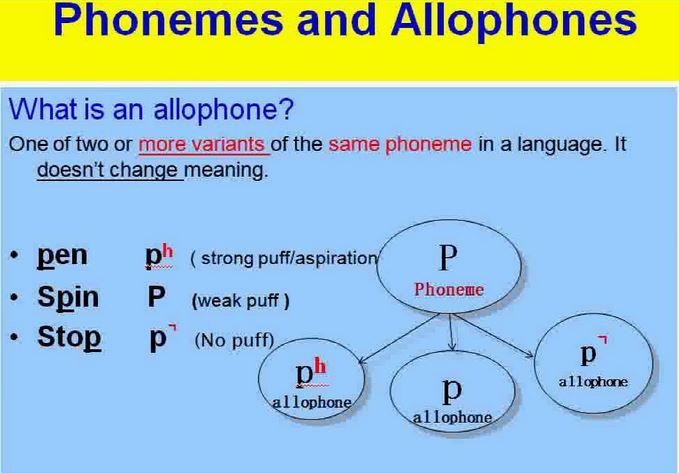In linguistics, an allophone is a variation of a phoneme—the smallest unit of sound in a language. Allophones are different sounds that do not change the meaning of a word and are perceived as the same phoneme by speakers of a particular language. These variations are usually caused by the phonetic environment in which a sound occurs, such as the sounds before or after it in a word.
This article explains the concept of allophones, how they function, and provides examples from English and other languages.
Phoneme vs. Allophone
- Phoneme: A phoneme is the smallest unit of sound that can distinguish meaning between words in a language. For example, the difference between the words “bat” and “pat” is the initial sounds /b/ and /p/, which are distinct phonemes.
- Allophone: An allophone is a variant of a phoneme that occurs in specific phonetic environments but does not alter the meaning of the word. Allophones are context-dependent variations in pronunciation. For example, in English, the /p/ sound in “pin” and “spin” is pronounced differently but both are perceived as the same /p/ phoneme by native speakers.
Types of Allophones
Allophones can occur in two major ways, based on their distribution in a language:
1. Complementary Distribution
In complementary distribution, allophones occur in specific environments where only one variant can appear, and they never contrast with each other in the same context. For example, the two allophones of a phoneme appear in distinct positions within a word and are not interchangeable.
- Example in English /p/:
- In “pin”, the /p/ sound is aspirated ([pʰ]), meaning it has a puff of air when pronounced.
- In “spin”, the /p/ sound is unaspirated ([p]), meaning it lacks the puff of air. Both sounds are allophones of the phoneme /p/ in English, and they occur in specific environments: the aspirated [pʰ] occurs at the beginning of a stressed syllable, while the unaspirated [p] occurs after the /s/ sound.
2. Free Variation
In free variation, allophones can appear in the same environment, and speakers can alternate between them without changing the meaning of the word. This variation often depends on regional accents, personal speaking style, or social context.
- Example in English /t/:
- In “cat”, some speakers may pronounce the /t/ as a fully released [t], while others may use a glottal stop [ʔ] (especially in some British and American dialects). Both pronunciations are acceptable, and the meaning remains the same.
Examples of Allophones in English
English provides many examples of allophones that vary depending on their position in a word or their surrounding sounds. Some common examples include:
- /t/ in “top” and “stop”:
- In “top”, /t/ is aspirated ([tʰ]) and pronounced with a puff of air.
- In “stop”, /t/ is unaspirated ([t]), occurring after /s/.
- /l/ in “light” and “full”:
- In “light”, /l/ is a clear or light /l/ ([l]), pronounced with the tongue raised towards the roof of the mouth.
- In “full”, /l/ is a dark /l/ ([ɫ]), where the tongue is further back in the mouth and the sound has a “velarized” quality.
- /k/ in “key” and “cool”:
- In “key”, the /k/ is pronounced as a palatalized [kʲ] due to the following front vowel /i/.
- In “cool”, the /k/ is pronounced as a velar [k] due to the following back vowel /u/.
Allophones in Other Languages
Many languages exhibit allophonic variation, often influenced by phonetic context, dialect, or speech register.
1. Spanish
In Spanish, the phoneme /d/ has two main allophones:
- [d] in initial positions (e.g., “dedo” [ˈdedo], meaning “finger”).
- [ð] (a voiced dental fricative, like the English “th” in “this”) between vowels (e.g., “nada” [ˈnaða], meaning “nothing”).
2. Korean
In Korean, the phoneme /p/ has multiple allophones:
- Aspirated [pʰ] in initial positions (e.g., “팔” [pʰal], meaning “arm”).
- Unaspirated [p] after /s/ (e.g., “스파” [sʰpʰa], meaning “spa”).
- In the final position, it is pronounced as a tense unreleased [p̚].
Causes of Allophonic Variation
Allophones result from a variety of phonetic and linguistic factors:
- Phonetic Environment: The sounds before or after a phoneme often influence its articulation. For example, aspiration in English occurs in stressed syllable-initial positions.
- Dialect and Accent: Speakers from different regions or backgrounds may produce different allophones for the same phoneme, leading to regional accents.
- Speech Context: Formal vs. casual speech, or fast vs. slow speech, can influence the use of allophones. Speakers may use more careful or precise articulation in formal settings.
Importance of Allophones
Understanding allophones is essential for several reasons in linguistics and language study:
- Phonology: It helps distinguish between phonemes (which change word meanings) and allophones (which do not).
- Language Learning: Recognizing allophonic variation is crucial for non-native speakers who need to learn how sounds vary in context without affecting meaning.
- Speech Recognition: In language technology and speech processing, identifying allophones is important for accurate transcription and recognition.
Allophones are variations of a phoneme that occur in different phonetic environments but do not change the meaning of words. They reflect the adaptability and fluidity of speech sounds in various contexts, influenced by factors like surrounding sounds, dialects, and speech styles. Recognizing allophones is essential in understanding how language operates at the sound level, helping both linguists and language learners grasp the complexity of spoken communication.



